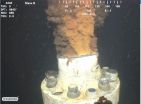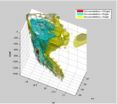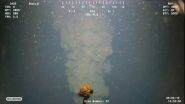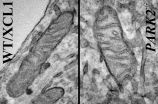New study finds a natural oil dispersion mechanism for deep-ocean blowout
Researchers carried out high-pressure laboratory experiments and simulate physical conditions at Deepwater Horizon's Macondo well blowout
2015-04-02
(Press-News.org) MIAMI - A first-of-its-kind study observed how oil droplets are formed and measured their size under high pressure. They further simulated how the atomized oil spewing from the Macondo well reached the ocean's surface during the Deepwater Horizon accident. The findings from the University of Miami (UM) Rosenstiel School of Marine and Atmospheric Science and University of Western Australia research team suggest that the physical properties in deep water create a natural dispersion mechanism for oil droplets that generates a similar effect to the application of chemical dispersants at oil spill source.
"These results support our initial modeling work that the use of toxic dispersants at depth should not be a systematic oil spill response," said Claire Paris, Associate Professor of Ocean Sciences at the UM Rosenstiel School. "It could very well be unnecessary in some cases."
The research team from C-IMAGE (Center for the Integrated Modeling and Analysis of the Gulf Ecosystem) conducted eight experiments to simulate different pressures of oil from a blowout at depth. The oil was placed in a high-pressure chamber, called a sapphire autoclave, and monitored using a high-speed, high-resolution camera to evaluate how droplets form at varying turbulent conditions.
"This is the first time that we've been able to visually monitor how droplets break up and coalesce at up to 120 times atmospheric pressure," said Zachary Aman, associate professor of mechanical and chemical engineering at the University of Western Australia. "When paired with the high pressures and flow rates of Macondo, the results suggest a natural mechanism by which oil is dispersed into small droplets."
The results of the laboratory experiment were applied in a field-scale simulation under the same physical conditions that existed during the Macondo well blowout. In the computer simulation, the team tracked the oil released at a constant rate of 1000 oil droplets every two hours at a depth of 300 meters above the Macondo well, corresponding to the depth of the observed deep plume, from April 20 to July 15, 2010, when the Macondo well was capped; droplets were tracked for an additional 24 days after the cap was in place.
Based on the experimental data and modelling, the researchers suggest that the use of chemical dispersants may have reduced the mean oil droplet diameter from about 80 to 45 µm, which would have reduced the amount of oil reaching the surface only by up to 3%. The model simulations showed that if the blowout occurred in shallow water conditions, or at a smaller rate of hydrocarbon release, dispersant may have had a more significant impact on the oil flowing from the well.
INFORMATION:
The research paper, entitled "High-pressure visual experimental studies of oil-in-water dispersion droplet size," will be published in the May 4 edition of the journal Chemical Engineering Science and is currently available in the online edition. The study's co-author's include Claire B. Paris and David Lindo-Atichati of the UM Rosenstiel School and Zachary Aman, Eric F. May and Michael L. Johns of the University of Western Australia.
About the University of Miami's Rosenstiel School
The University of Miami is one of the largest private research institutions in the southeastern United States. The University's mission is to provide quality education, attract and retain outstanding students, support the faculty and their research, and build an endowment for University initiatives. Founded in the 1940's, the Rosenstiel School of Marine & Atmospheric Science has grown into one of the world's premier marine and atmospheric research institutions. Offering dynamic interdisciplinary academics, the Rosenstiel School is dedicated to helping communities to better understand the planet, participating in the establishment of environmental policies, and aiding in the improvement of society and quality of life. For more information, visit: http://www.rsmas.miami.edu.
About C-IMAGE
C-IMAGE is one of eight GoMRI-funded consortia conducting research in the Gulf with scientists from 14 institutions and four countries that is dedicated to contributing to the goals of the GoMRI. C-IMAGE's priority is to integrate field and laboratory studies with state of the art modeling to understand historical oil spills in the Gulf and to be better prepared to predict impacts of future spills.
ELSE PRESS RELEASES FROM THIS DATE:
2015-04-02
Binge-drinking during adolescence may perturb brain development at a critical time and leave lasting effects on genes and behavior that persist into adulthood.
The findings, by researchers at the University of Illinois at Chicago College of Medicine using an animal model, are reported online in the journal Neurobiology of Disease.
"This may be the mechanism through which adolescent binge-drinking increases the risk for psychiatric disorders, including alcoholism, in adulthood," says lead author Subhash Pandey, professor of psychiatry and director of neuroscience alcoholism ...
2015-04-02
Irvine, Calif. -- A newly developed website provides parents and children with individualized information and support -- based on factors like coping style and levels of worry and fear -- to help lower anxiety before outpatient surgery in children, according to a pair of articles in the April issue of Anesthesia & Analgesia.
The papers report on the development of the "Web-based Tailored Intervention Preparation for Surgery" (WebTIPS) project, which provides information and strategies to help children and parents prepare for surgery and anesthesia. A preliminary evaluation ...
2015-04-02
Based on research in fruit flies, it has long been suspected that the most common mutation linked to both sporadic and familial Parkinson's disease (PD) wreaks its havoc by altering the function of mitochondria in neurons that produce the neurotransmitter dopamine. Using stem cells derived from patients who have PD, scientist at the Buck Institute have confirmed that finding in human cells for the first time. In research published in the April 2nd early online edition of Stem Cell Reports, Buck researchers also provide a valuable tool for testing potential treatments ...
2015-04-02
BOSTON -- Pseudogenes, a sub-class of long non-coding RNA (lncRNA) that developed from the genome's 20,000 protein-coding genes but lost the ability to produce proteins, have long been considered nothing more than genomic "junk." Yet the retention of these 20,000 mysterious remnants during evolution has suggested that they may in fact possess biological functions and contribute to the development of disease.
Now, a team led by investigators in the Cancer Research Institute at Beth Israel Deaconess Medical Center (BIDMC) has provided some of the first evidence that one ...
2015-04-02
The ability to learn associations between events is critical for survival, but it has not been clear how different pieces of information stored in memory may be linked together by populations of neurons. In a study published April 2nd in Cell Reports, synchronous activation of distinct neuronal ensembles caused mice to artificially associate the memory of a foot shock with the unrelated memory of exploring a safe environment, triggering an increase in fear-related behavior when the mice were re-exposed to the non-threatening environment. The findings suggest that co-activated ...
2015-04-02
(Boston)--Using patient-derived stem cells known as induced pluripotent stem cells (iPSC) to study the genetic lung/liver disease called alpha-1 antitrypsin (AAT) deficiency, researchers have for the first time created a disease signature that may help explain how abnormal protein leads to liver disease.
The study, which appears in Stem Cell Reports, also found that liver cells derived from AAT deficient iPSCs are more sensitive to drugs that cause liver toxicity than liver cells derived from normal iPSCs. This finding may ultimately lead to new treatments for the condition.
IPSC's ...
2015-04-02
Capitalizing on a rare opportunity to thoroughly analyze a tumor from a lung cancer patient who had developed resistance to targeted drug treatment, UC San Francisco scientists identified a biological escape hatch that explains the resistance, and developed a strategy in mice for shutting it down.
In experiments that combined the drug the patient had taken with a second compound that blocks off this newly discovered resistance pathway, the researchers were able to durably wipe out cancer cells in mice implanted with cells from the drug-resistant tumor.
"Even in cancers ...
2015-04-02
CANCER RESEARCH UK scientists have discovered that a vital self-destruct switch in cells is hijacked - making some pancreatic and non small cell lung cancers more aggressive, according to research published in Cancer Cell today (Thursday)*.
The team, from the Cancer Research UK Centre at the UCL (University College London) Cancer Institute, found that mutations in the KRAS gene interferes with protective self-destruct switches, known as TRAIL receptors, which usually help to kill potentially cancerous cells.
The research, carried out in cancer cells and mice, shows ...
2015-04-02
Researchers have identified a new genetic mutation at the heart of a severe and potentially deadly seizure disorder found in infants and young children. The finding, which was reported today in the journal American Journal of Human Genetics, may help scientists unravel the complex biological mechanism behind these diseases.
"These findings allow us to open up what was, up to this point, a 'black box' and more fully understand the biological pathways associated with these disorders and why some individuals do not respond to treatment," said Alex Paciorkowski, M.D., an ...
2015-04-02
In one of the first studies to examine the potential for using municipal wastewater as a feedstock for algae-based biofuels, Rice University scientists found they could easily grow high-value strains of oil-rich algae while simultaneously removing more than 90 percent of nitrates and more than 50 percent of phosphorous from wastewater.
The findings, which are based on a five-month study at a wastewater treatment facility in Houston, are available online in the journal Algae.
"Biofuels were the hot topic in algaculture five years ago, but interest cooled as the algae ...
LAST 30 PRESS RELEASES:
[Press-News.org] New study finds a natural oil dispersion mechanism for deep-ocean blowout
Researchers carried out high-pressure laboratory experiments and simulate physical conditions at Deepwater Horizon's Macondo well blowout




